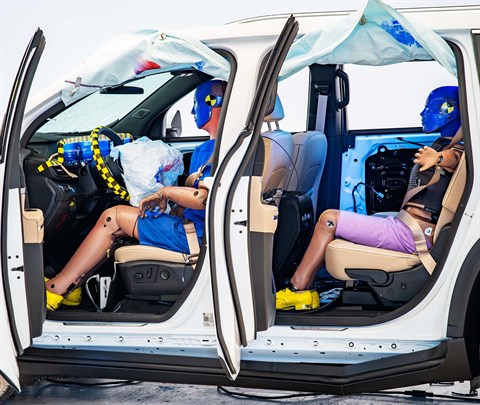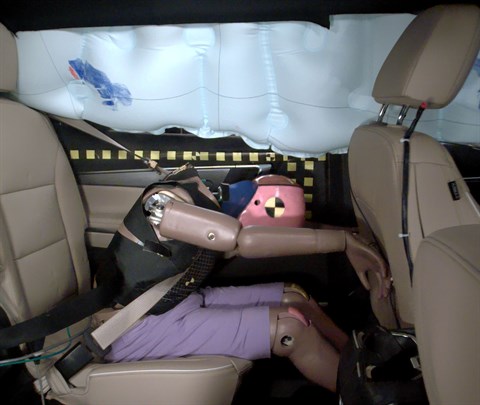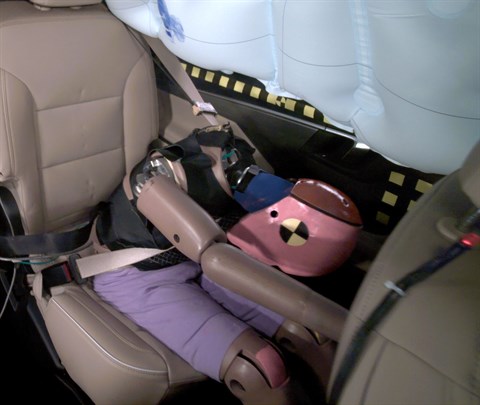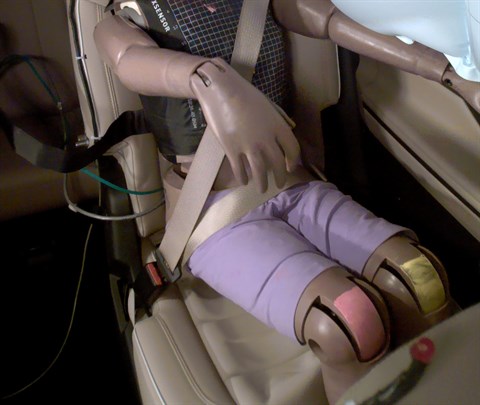Small overlap front
The small overlap front evaluation consists of a driver-side and a passenger-side component. If the results of the two evaluations differ, then the combined small overlap rating is equal to the lower rating.
Driver-side
- Rating applies to 2025 models
Tested vehicle: 2025 Buick Enclave Avenir 4-door 4wd
The Buick Enclave was redesigned for the 2025 model year. Driver-side small overlap front ratings are assigned by the Institute based on a test of a 2025 Enclave conducted by General Motors
| Evaluation criteria | Rating |
|---|---|
| Overall driver-side evaluation | |
| Structure and safety cage | |
| Driver injury measures | |
| Head/neck | |
| Chest | |
| Hip/thigh | |
| Lower leg/foot | |
| Driver restraints and dummy kinematics | |
Passenger-side
- Rating applies to 2025 models
Tested vehicle: 2025 Buick Enclave 4-door 4wd
The Buick Enclave was redesigned for the 2025 model year. Passenger-side small overlap front ratings are assigned by the Institute based on a test of a 2025 Enclave conducted by General Motors
| Evaluation criteria | Rating |
|---|---|
| Overall passenger-side evaluation | |
| Structure and safety cage | |
| Passenger injury measures | |
| Head/neck | |
| Chest | |
| Hip/thigh | |
| Lower leg/foot | |
| Passenger restraints and dummy kinematics | |
| Driver injury measures | |
| Head/neck | |
| Chest | |
| Hip/thigh | |
| Lower leg/foot | |
| Driver restraints and dummy kinematics | |
Moderate overlap front: updated test
Rating applies to 2025 models
Tested vehicle: 2025 Buick Enclave Preferred 4-door 4wd
The Buick Enclave was redesigned for the 2025 model year.
| Evaluation criteria | Rating |
|---|---|
| Overall evaluation | |
| Structure and safety cage | |
| Driver injury measures | |
| Head/neck | |
| Chest | |
| Thigh/hip | |
| Leg/foot | |
| Driver restraints and dummy kinematics | |
| Rear passenger injury measures | |
| Head/neck | |
| Chest | |
| Thigh | |
|
Rear passenger restraints and dummy kinematics
| |

View of the vehicle after the crash showing the airbags and damage to the occupant compartment.

The rear passenger dummy's head approached the front seatback, which increases the risk of head injuries.

Rear passenger dummy injury values indicate a low risk of injury to the chest and a moderate risk of injury to the head or neck. During the crash, the shoulder belt remained in an ideal position on the dummy’s chest.

The rear passenger dummy's lap belt remained in the ideal position on the pelvis.
Side: updated test
Rating applies to 2025 models
Tested vehicle: 2024 GMC Acadia Uplevel 4-door 4wd
The GMC Acadia was redesigned for the 2024 model year. Side 2.0 ratings are assigned by the Institute based on a test of a 2024 Acadia conducted by General Motors. These ratings also apply to the Chevrolet Traverse and newly redesigned Buick Enclave.
| Evaluation criteria | Rating |
|---|---|
| Overall evaluation | |
| Structure and safety cage | |
| Driver injury measures | |
| Head/neck | |
| Torso | |
| Pelvis | |
| Driver head protection | |
| Rear passenger injury measures | |
| Head/neck | |
| Torso | |
| Pelvis | |
| Rear passenger head protection | |
Headlights
Ratings are given for 2 different headlight variations available on this vehicle.
Trim level(s)
- All trims; built after January 2025
| Evaluation criteria | Rating |
|---|---|
| Low-beam headlight type | LED projector |
| High-beam headlight type | LED projector |
| Curve-adaptive? | No |
| High-beam assist? | Yes |
|
Overall rating | |
| Distance at which headlights provide at least 5 lux illumination: | |
Low beams
On the straightaway, visibility was good on both sides of the road. On curves, visibility was good in all 4 tests.
The low beams created some glare.
High beams
On the straightaway, visibility was good on the right side of the road and inadequate on the left side. On curves, visibility was good on the gradual left and both right curves and fair on the sharp left curve.
Trim level(s)
- All trims; built before February 2025
| Evaluation criteria | Rating |
|---|---|
| Low-beam headlight type | LED projector |
| High-beam headlight type | LED projector |
| Curve-adaptive? | No |
| High-beam assist? | Yes |
|
Overall rating | |
| Distance at which headlights provide at least 5 lux illumination: | |
Low beams
On the straightaway, visibility was good on both sides of the road. On curves, visibility was good in all 4 tests.
The low beams created some glare.
High beams
On the straightaway, visibility was good on the right side of the road and inadequate on the left side. On curves, visibility was good on the gradual left and both right curves and fair on the sharp left curve.
Front crash prevention: vehicle-to-vehicle 2.0
Front crash prevention: pedestrian
Seat belt reminders
Rating applies to 2025 models
| Evaluation criteria | Rating |
|---|---|
| Overall evaluation | |
| Front row | |
| Unbelted occupant alert (audible & visual) | |
| Initiation time | |
| Duration | Long enough (90+ seconds) |
| Volume | |
| Audio frequency | |
| Second row | |
| Startup status alert (visual) | |
| Initiation time | |
| Duration at least 60 seconds | |
| Belt disengaged alert (audible & visual) | |
| Initiation time | |
| Duration at least 30 seconds | |
| Volume | |
| Audio frequency | |
